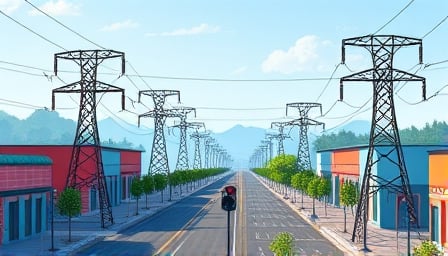Corporate Analysis: DTE Energy’s Recent Corporate Actions and Their Implications for Grid Modernization
DTE Energy Co., a diversified utility operating across the United States, has announced a series of corporate governance updates and a substantial bond issuance that signal its strategic focus on infrastructure investment and regulatory compliance. While the company’s equity performance has lagged behind the broader utilities sector, the recent actions illustrate a proactive stance toward strengthening capital resources, optimizing executive remuneration, and aligning with evolving policy frameworks that shape the future of power generation, transmission, and distribution.
Corporate Governance Enhancements
Executive Severance and Control Policies
DTE Energy has amended its executive severance provisions to incorporate more stringent conditions linked to the company’s performance metrics, including key indicators of grid reliability and renewable integration. The revised framework ties severance payouts to both financial results and technical benchmarks, ensuring that senior leadership remains accountable for maintaining grid stability amid the increasing penetration of variable renewable resources.
Executive Compensation and Indemnification Adjustments
The company’s updated compensation structure introduces performance‑based incentives that align with utility objectives such as outage reduction, voltage quality improvement, and compliance with the Federal Energy Regulatory Commission (FERC) reliability standards. Indemnification policies have also been broadened to cover emerging risks associated with distributed energy resources (DERs) and advanced grid management technologies, thereby encouraging investment in modern control systems without exposing executives to disproportionate liability.
Capital Market Activity: $600 Million Bond Sale
DTE Energy closed a long‑term bond issuance of over $600 million, maturing in 2085. This strategic move provides a low‑cost capital base to fund extensive infrastructure upgrades, including:
- Transmission Reinforcement: Reinforcing high‑voltage corridors to accommodate bidirectional flows from rooftop solar, community wind farms, and electric vehicle charging stations.
- Distribution Modernization: Deploying smart grid sensors, automated switchgear, and energy storage solutions to improve resilience and support demand‑response programs.
- Renewable Integration: Expanding interconnection capacity and upgrading substation automation to mitigate voltage variability and maintain power quality.
The bond’s extended maturity aligns with the utility’s long‑term investment horizon, allowing DTE Energy to spread capital costs over several decades while maintaining a competitive credit rating. Regulatory oversight from the Public Utility Commission (PUC) and FERC will continue to monitor the utilization of these funds to ensure compliance with rate‑of-return and cost‑of-service regulations.
Event and Stakeholder Engagement
DTE Energy’s upcoming annual event, Hallelujah for Heat, scheduled for October 25 in Detroit, serves as a platform to communicate the company’s progress on grid modernization initiatives. The event will showcase case studies on smart meter deployment, electric vehicle infrastructure rollout, and community solar programs, illustrating how these investments translate into improved grid reliability and lower consumer costs.
Regulatory and Economic Context
Regulatory Frameworks
- FERC Reliability Standards: DTE Energy must adhere to Part 830 (Reliability Standards for Bulk Electric Systems) and Part 861 (Transmission Planning) guidelines, which now increasingly cover distributed resources and demand‑side flexibility.
- State-Level Renewable Portfolio Standards (RPS): The utility operates in jurisdictions with aggressive RPS mandates, compelling substantial investment in renewable generation and ancillary services.
- Rate Structures: DTE’s cost‑of‑service rates are subject to PUC approval. The company’s bond proceeds will be reflected in future rate cases, potentially enabling ratepayer‑friendly financing of grid upgrades without imposing significant rate hikes.
Economic Impacts of Modernization
Investments financed through the bond issuance are projected to yield multiple economic benefits:
- Enhanced Reliability: Reduced outage frequency and duration lead to lower direct costs for consumers and businesses.
- Grid Flexibility: Advanced monitoring and control systems enable better handling of renewable intermittency, decreasing reliance on costly peaking plants.
- Job Creation: Infrastructure projects stimulate local employment in engineering, construction, and system integration sectors.
Conversely, the long‑term debt obligation will be factored into ratepayer assessments. Transparent communication of cost‑benefit analyses will be essential to mitigate potential consumer resistance, especially in regions where ratepayer advocacy groups scrutinize utility spending on non‑essential projects.
Technical Insights into Power System Dynamics
Grid Stability and Renewable Integration
The increasing share of solar and wind generation introduces challenges such as:
- Voltage Regulation: Rapid fluctuations in generation can cause voltage sags or swells. DTE’s plan to deploy voltage‑regulating transformer tap changers and static VAR compensators will mitigate these effects.
- Frequency Control: The loss of synchronous inertia from conventional generators is counteracted by installing battery storage and utilizing inverter‑based resources that can provide synthetic inertia.
- Contingency Management: Real‑time monitoring of line flows and automated fault isolation systems help maintain system stability during contingencies.
Distribution System Modernization
Smart grid technologies will enable:
- Dynamic Load Shedding: Automated demand‑side response can balance supply and demand in real time, reducing peak loads and preventing voltage collapse.
- Microgrid Formation: Isolated sections can operate autonomously during faults, preserving service continuity.
- Asset Health Monitoring: Predictive maintenance algorithms detect degradation in transformers and cables before failure, optimizing asset life cycles.
Conclusion
DTE Energy’s recent corporate governance adjustments and robust bond issuance demonstrate a commitment to sustaining and upgrading its power transmission and distribution infrastructure. By aligning executive incentives with grid reliability and renewable integration metrics, the company positions itself to navigate regulatory requirements while delivering long‑term value to ratepayers. The strategic deployment of capital toward smart grid technologies and renewable interconnection will not only enhance grid resilience but also support the broader energy transition, balancing consumer cost considerations with societal goals of decarbonization and sustainable development.
